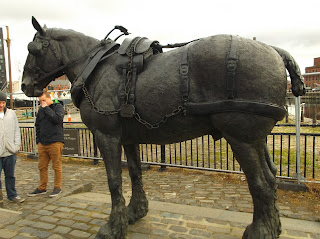Walk
200 Liverpool to Cressington (alongside the Mersey)
(Fourth
leg of English coastal walk – Gretna Green to Chester)
Map:
L/R 108
Distance:
6 miles or 10 km approx
Difficulty:
Easy, flat.
Terrain:
concrete paved river walk
Access:
Parking in both places
Public
transport: Frequent trains between Cressington and Liverpool Central.
Although
the walk starts near the Liver Building, Liverpool itself has much to
offer of interest. At least a day can be spent looking around. I
particularly enjoyed the Walker Art Gallery, The Roman Catholic
Cathedral (known locally as Paddy’s Wigwam), Liverpool Cof E
Cathedral designed by Gilbert Scott and, at 189 metres, the longest
in the world, The Slave Museum, Rodney Street (for old photographic
NT studio and pyramid tomb), The Philarmonic Pub and Matthew Street
(Cavern Club). Some others are mentioned below on the walk.
Soon
after The Liver Building is the Liverpool Cruise Terminal – a
floating structure oepned in 2007. A bit further along is The Titanic
Memorial which is dedicated to the 224 engine room staff who lost
their lives. They remained at their posts supplying electricity and
other amenities so others could survive. On the land side you cannot
miss the impressive Port of Liverpool Building formerly the Mersey
Docks and Harbour Board offices. Clad in Portland stone it is a
listed building. In front of the building is the statue of Sir Alfred
Lewis Jones a shipowner who was the founder of the Liverpool School
of Tropical Medicine.
Departures
for the world famous ferry across the Mersey are on the riverside.
Past this point are a number of sculptures to admire. These include:
Captain F J Walker 1896-1944 dedicated to him and all those who
fought in the Battle of the Atlantic in World War 2; sculptures
outside the Museum of Liverpool celebrating 2008 when the city was
the European Capital of Culture; the propeller from the Lusitania
which was torpedoed in 1915 with the loss of 1201 lives; the Working
Horse Monument marking the importance of horses which for 250 years
pulled goods around the city; Billy Fury the pop singer who died at
42. Near the Tate Gallery are sculpted figures commemorating the 9
million people who emigrated from Liverpool to the New World. I could
go on!
This
area, part of the Old Albert Dock, was a complex of buildings opened
in 1846. It was a base for the Atlantic Fleet in World War 2. Near
here is The Beatles Experience – I did not have time to go in here
though.
Continue
the walk past the Liverpool Museum (although you will need to wander
back away from the river as well to appreciate all that is on offer
in this former docks area). On the front is The Old Pilot Office in
use between 1883 and 1978. It was the base for the service which is
still use today, that of providing a pilot to vessels entering and
leaving the Mersey.
Further
along is The Liverpool Arena and the Ferris wheel. After this there
is less hustle and bustle as the walk passes park land alongside the
Mersey. Otterpool Promenade was opened in 1950 and was made by
landscaping a waste disposal site. The name derives from the otters
that inhabited a tidal creek that joined the River Mersey.
This
walk is quite pleasant although the industry at Garston and beyond
gets ever closer. You are nearing the end when you spot the large
pink sculpture called Sitting Bull near to the river side at
Aigburth. This is a sculpture created for a local garden festival in
1984. The walk for this part of t\he coast finishes at Cressington.
Photos show: Working horse sculpture, Albert Dock, Liverpool; part of Albert Dock; Otterpool; Sitting Bull, Aigburth.




No comments:
Post a Comment